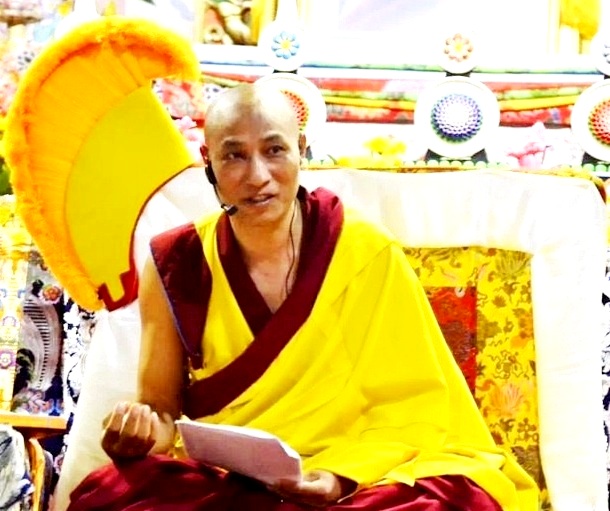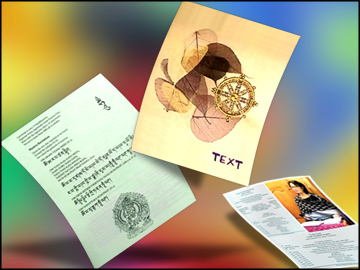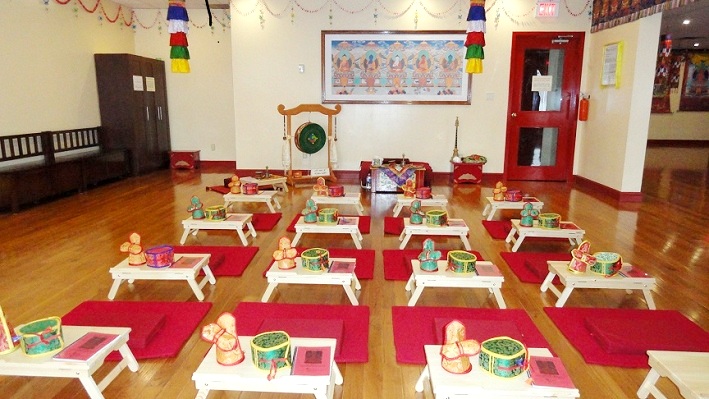|
|
 |
TOPICS OF TEACHINGS ON LAMRIM (GRADUAL STAGES ON
THE PATH TO ENLIGHTENMENT)

TIÊU ĐỀ CỦA CÁC BÀI PHÁP THOẠI VỀ NHỮNG GIAI ĐOẠN
THỨ LỚP CỦA CON ĐƯỜNG ĐƯA ĐẾN GIÁC NGỘ
|
 |


Since the year 2006,
His Eminence The 9th Tulku
Neten Rinpoche has been residing in Toronto, Canada but travels
extensively across the globe for public talks and giving teachings
to religious, educational, healthcare and social institutions.
All His Eminence's teachings were translated directly from
TIBETAN into ENGLISH,
FRENCH and VIETNAMESE
by
Nguyễn Mai-Phương
Bắt đầu từ
năm 2006, Ngài Tulku Neten Rinpoche
hóa thân đời thứ 9
chính thức định cư tại Toronto Canada và hoằng Pháp khắp nơi
trên thế giới
trong mọi lãnh vực về tôn giáo, tâm linh,
giáo dục, sức
khỏe
và xã hội.
Nguyễn Mai-Phương
dịch trực tiếp từ tiếng Tây Tạng sang tiếng ANH, PHÁP và VIỆT
tất cả các
bài Pháp thoại của
Ngài.
  
The following
TEACHINGS OF SUTRA & TANTRA
have been
taught by
HIS EMINENCE TULKU
NETEN RINPOCHE
in
Canada, USA, Europe & Asia since the year 2006.
His Eminence has received oral transmissions
from His Holiness The Dalai Lama and Teachers
of the lineage for these Teachings,
Initiations-Empowerments and Practice
Ngài Tulku Neten Rinpoche giảng dạy các đề mục dưới đây
từ KINH ĐIỂN & MẬT ĐIỂN
tại các nước
Gia Nã Đại, Mỹ, Âu Châu & Đông Nam Á
từ năm 2006.
Ngài đã nhận khẩu
truyền từ Đức Dalai Lama và các bậc Thầy của giòng truyền thừa cho sự
giảng dạy Phật Pháp, Quán đảnh và tu tập.
TOPICS OF TEACHINGS
ON LAMRIM
(THE GRADUAL STAGES OF THE PATH TO ENLIGHTENMENT)
SINCE THE YEAR 2006 TO NOW
TIÊU ĐỀ
CỦA CÁC BÀI LUẬN GIẢI
VỀ LAMRIM
(NHỮNG GIAI ĐOẠN THỨ LỚP CỦA CON ĐƯỜNG ĐƯA ĐẾN GIÁC NGỘ)
TỪ NĂM 2006 CHO ĐẾN BÂY GIỜ
Condensed Points of the Stages of the Path
to Enlightenment (LAMRIM)
Những
điểm tinh yếu của các giai đoạn của con
đường Giác Ngộ (LAMRIM)
The greatness of the originator
The
greatness of the Dharma
The method of listening to and teaching Dharma
The correct manner of listening to Dharma
The correct
manner of teaching Dharma
Activities to
be performed by Teachers and listeners
The
Root of The Path -
Practice of Guru Yoga: Spiritual Teacher (Guru) Devotion
The Foundation of All
Good Qualities
Generating Enthusiasm for Serving a Spiritual Teacher
Serving a Spiritual Teacher through Thought
Serving a Spiritual Teacher through Action
Six-Session of Guru Yoga
Guru Puja (Lama Chopa)
The Practice of Guru Yoga: The Union of Bliss and Emptiness
The Hundreds of Deities of the Joyful Land Tushita
The Seven Wisdoms
Training The Mind Through Meditation - Stage I: Six Preliminary Practices
Meaning and Benefits of the Mandala Offering - Practice for
accumulating merits and purifying negativities
An admonition and method to derive value from a human form that
has leisure and fortune
THE STAGE OF PATHS OF THE THREE TYPES OF PERSON: SMALL, MIDDLING ANS
GREAT SCOPES
Training
the mind in the levels of the path that are held in common with people of
LESSER CAPACITY (SMALL
SCOPE)
-
Luyện Tâm Ở
Trình Độ Của Đạo Lộ Chung Dành Cho Những Hành Gỉa
Thuộc
PHẠM VI hay CĂN CƠ NHỎ
Generating an attitude
of concern for future lives and Pursuing the methods of achieving
happiness in future lives
The Sutra of Truly
Remembering The Sublime Three Jewels
Taking Refuge – the sacred door by which the teaching is entered
The Four Great
Festivals
The Twelve Deeds of Buddha Shakya Muni and Qualities (body, speech, mind and activities) of the Buddha
The Four Noble Truths
The Twelve Links of Dependent Originations
Karma and The Law of Cause and Effect
Ten Non-Virtuous Deeds caused by body, speech and mind that one must
abandon
How
to purify ourselves by means of the Four Powers
Practice of Four Fundamental Minfulnesses:
body, feeling, mind and phenomena
The Seven-limb Practice:
Prostrations,
Making Offering,
Purification Negativities,
Rejoicing in the wholesome actions of others and oneself,
Requesting for Turning the Dharma Wheel,
Requesting
for Not Entering into Parinirvana,
Dedicating Merit
Five Essential Strengths applied to transform any situation into
Dharma Practice:
Intention, White seed, Repeated practice, Remove obstacles, and
Prayer
Recalling death and meditating on the nine points relating to death
Contemplating the suffering of lower realms: hells, hungry ghosts
and animals
Death and Impermanence
Death, Intermediate State and Rebirth
A combination of instructions that should be practiced throughout
our life
The Practice applied for the
happiness in this
life, at the time of Death, and in the Intermediate State (Bardo)
for obtaining a good Rebirth
Training
the mind in the levels of the path that are held in common with people of
MODERATE CAPACITY (MIDDLING SCOPE)
-
Luyện Tâm Ở
Trình Độ Của Đạo Lộ Chung Dành Cho Những Hành Gỉa
Thuộc PHẠM VI hay CĂN CƠ TRUNG BÌNH
Developed the aspiration
to achieve liberation and practice the path that
leads to liberation
The Four Noble Truths
Developing the aspiration to achieve liberation
Contemplating the specific types of suffering in samsara
Contemplating the specific types of suffering in samsara (lower and
higher states)
Nature of the path that
leads to liberation
The origin of
suffering
How the mental afflictions arise
-
Identify the mental afflictions:
six root mental afflictions and twenty secondary mental afflictions
-
The order in which the mental afflictions arise
-
The perishable-collection view: conceptual and innate
-
The causes of mental afflictions
-
The disadvantages of mental afflictions
-
How the mental afflictions
cause us to accumulate karma
How we die and are reborn
How death occurs
How death is followed by entrance into the intermediate state (Bardo)
How rebirth occurs at conception
Twelve limbs of Dependent Origination
Training in
the
path that leads to liberation
The type of human form that we need to
escape from samsara
The
type of path that must be practiced to escape from the samsara
Parting away from the Four Clingings [5]
Training
the mind in the levels of the path that are held in common with people of
GREAT CAPACITY (GREAT
SCOPE)
-
Luyện Tâm Ở
Trình Độ Của Đạo Lộ Chung Dành Cho Những Hành Gỉa
Thuộc PHẠM VI hay CĂN CƠ LỚN
Outline of main points - Nội dung của những
điểm chính
The
enlightenment mind is the sole means of entering the Mahayana and
its benefits
How to generate
enlightenment mind Bodhichitta
How to train oneself
in the Bodhisattva activities
1. Training oneself in
six perfections: generosity, ethical discipline, patience, joyous
effort, concentration and wisdom
2. Training oneself in
the perfection of concentration and wisdom
2.1. Training oneself
in quiescence, which is the essence of one-pointed meditation
2.2. Training oneself
in insight, which is the essence of wisdom
2.2.1. Establishing
the insubstantiality of the self
2.2.2. Establishing
the insubstantiality of phenomena
2.2.3. The method of
developing insight
2.2.4. How to train
oneself in the Vajrayana path
3. The four methods of gathering followers
and guiding them to the Dharma
----------
(Teachings include the explanation of
the essence of Mind Only School and Middle Way School)
Generating the enlightenment mind (Bodhichitta)
The Stages for Training Oneself in Enlightenment Mind
-
Training the mind with the instruction called Sevenfold Instruction
of Cause and Effect
-
Training the mind with the instruction called Equality and Exchange
of Self and Others
Ritual
method of adopting enlightenment mind: gaining and preserving the
vow
-
Teachings and Ritual for Receiving Vows
-
Taking Refuge to the Three Jewels and the precepts to be observed
-
Bodhisattva Vows
-
Mahayana Vows (8 precepts)
Practice of the Bodhichitta
Training oneself in the Bodhisattva activities once enlightenment
mind has been generated
Practice of the Six Perfections:
-
Perfection of Giving,
-
Perfection of
Ethics,
-
Perfection of Patience,
-
Perfection of Effort,
-
Perfection of Concentration and
-
Perfection of Wisdom
Various Instructions on Mind Training
Transforming the Mind: A Practice Based On Mind Training
Instructions
Guarding Introspection
Compassion and Wisdom
The
Power of Compassion
The Four Immeasurables: Immeasurable Love, Compassion, Joy,
Equanimity
Green Tara and Twenty-One Tara teachings and practice
Buddha of Compassion Avalokiteshvara, Mantras teachings and
the practice of Nectar Purification
Five
Strengths applied in one's life
Training The Mind Through Meditation
Part I - Six Preliminary Activities
Part II -
How to train oneself in Quiescence,
which is the essence of One-Pointed Meditation
Part III -
How to train oneself in Special
Insight, which is the essence of Wisdom

COMMENTARY ON PHILOSOPHICAL
TREATISES
GIẢNG GIẢI NHỮNG BỘ LUẬN
The Heart Sutra (The Perfection of Wisdom)
Introduction
- The Text and its
Meaning
-
Five
Aggregates, Eight Areas, Twelve Sources of Perception
-
The Twelve Links
of Dependent Origination
- The Sixteen Distorted Views concerning the Four Noble Truths
-
How the mental afflictions arise and cause us to accumulate karma
and suffering
-
The Thirty-Seven
Aspects of The Path To Enlightenment,
show
specifically how the principles of the Four
Noble Truths are to be applied in one's
day-to-day spiritual life
-
The Four Seals
-
The Two Truths: Conventional and Ultimate Truths
- The
Eight Aspects of Emptiness and The Three Doors of Liberation
-
Nirvana: Natural Nirvana, Isolated peace of
Individual Nirvana and Non-Abiding
Nirvana
-
Emptiness and Dependent Arising
-
The
Relationship Between the Understanding of
Emptiness and the Five Stages of the Path to Enlightenment
- Advanced teachings on
The Heart Sutra and explanation of difficult points
- Review
the foundation taught from the Introduction to the Heart Sutra
teaching
- The
mantra of the Perfection of Wisdom
-
The Ten Grounds
and The Five Paths according to the two Vehicles: The Perfection and
The Tantra
- The Luminous Nature of The Mind
- The
Buddha Nature is defined in The Mind Only School and The
Middle Way School
- Selflessness
----------
The Foundation of All
Good Qualities
based on the
Great Treatise LAMRIM. See
TEXT for
more information
- The
Root of The Path -
Practice of Guru Yoga: Spiritual Teacher (Guru) Devotion
-
An admonition and method to derive value from a human form that
has leisure and fortune
-
The Stages of Paths of the Three Types of Person: Small, Middling
and Great Scopes
- How to train oneself
in Quiescence, which is the essence of One-Pointed Meditation
- How to train oneself
in Special Insight, which is the essence of Wisdom:
(1) establishing the
insubstantiality of the self
(2) establishing the insubstantiality of
entities and
(3) method of developing insight
How to cultivate
the space-like realization DURING a state of mental composure
How to cultivate
the realization that all conventional entities are like illusions
AFTER a period of mental composure
How to train oneself
in the Vajrayana Path (Tantra): Two Attainments
(Common and Supreme) and Two Stages (Generation and Completion)
Vows and practice
(Details refered to the teaching on the Heart Sutra,
Thirty-seven Practices of
Bodhisattvas, and Lamp for the Path of Enlightenment of Atisha, taught by His Eminence
Tulku Neten Rinpoche in the year 2014 and 2015)
----------
Je
Shantideva’s Compendium of All Practices
Je
Shantideva’s The Way of The Bodhisattva (Bodhicharyavatara)
The
Bodhicharyavatara or "The Bodhisattva's Way of Life" composed in the
8th century by the Bodhisattva Shantideva, who was accepted and
blessed by his supreme deity Manjushri, has occupied an important
place in the Tibetan Buddhist tradition almost from its inception.
This is one of the great classics of Mahayana Buddhism, it describes
the path of practice of the Bodhisattvas to become enlightened for
the benefits of all sentient beings.
Part One: The Generation of
Bodhichitta Where It Has Not Previously Existed
I. The Excellence and Benefits of the
Bodhichitta,
II. Confession of negativities,
III. Taking hold of the Bodhichitta
Part Two: How To Prevent Bodhichitta
From Weakening Once It Has Been Generated
IV. Carefulness,
V. Vigilant instrospection
VI. Perfection of Patience
Part Three: How Bodhichitta Is To Be Developed
and Intensified
VII. Perfection of Enthusiastic
Perseverence
VIII. Perfection of Meditative Concentration
IX. Perfection of Wisdom
Part Four: Dedication Of The Resulting Merits
For The Benefit Of Others
X. Dedication
----------
The Five Works of Buddha Maitreya and Bodhisattva Asanga
1. The Ornament of Clear Realization:
this work is a verse
commentary on the Prajnaparamita literature and is divided into
eight vajra topics.
2. The Ornament of Mahayana Discourses: covers a discussion of Buddha nature, refuge in the Three Jewels,
the Mahayana Path, and the doctrine of emptiness.
3. Distinguishing the Middle from the Extremes: a commentary
primarily on the Cittamatra (Mind Only) School, explores eternalism and
nilhilism and why these are not part of the Middle Way.
4. Distinguishing Dharma and Dharmata:
a commentary on the Tathagatagarbha doctrine and the Cittamatra (Mind Only) School of thought.
5. The Uttaratantra: this is mainly a commentary on the Three Jewels, the seed of Buddha
nature, the attributes, activities of the Buddha and the development
of the realization of the nature of phenomena through the
purification of the disturbing emotions.
----------
Lama Chopa The Practice of Guru Yoga (Sanskrit:
Guru Puja):
"The Union of Bliss and
Emptiness",
the Tantric practice and
"The Gradual Stages of
the Path to Enlightenment", the
practice of Sutra
Lama Chopa
Tu Tập Pháp
Đạo Sư Du Già
(tiếng Phạn: Guru Puja):
"Sự Hợp Nhất của Hỷ Lạc và Tánh Không" tu
tập Mật Điển và
"Những Giai Đoạn Thứ Lớp của Con Đường
Đưa Đến Giác Ngộ" tu tập
Kinh Điển
----------
Je
Atisa’s Lamp for The Path to Enlightenment
Presents a complete summary of all
the main points of sutra and tantra as instructions for controlling
the mind practiced by persons of three different capacities. It
contains the quintessential thought of Buddhas and the hidden and
explicit subject-matter of the Perfection Wisdom sutras.
Je Tsongkhapa’s The Three Principal Aspects of The Path:
Renunciation - Bodhichitta - and Correct View
Je
Langri Tangpa's The Eight Verses for Training The Mind -
Introduction
and
Advanced Teachings
Je
Chekawa's The Seven Points of Mind Training
Je
Thogme Sangpo's
The Thirty-Seven Practices of Bodhisattvas
The Way to Enter the VAJRAYANA
or TANTRA:
Overview of
Buddist Tantra
Bodhisattva
Aryadeva's Four Hundred Stanzas On The Middle Way
Bodhisattva
Nagarjuna's Precious Garland
Bodhisattva
Nagarjuna's
Six Logics
The Hundreds of Deities of the Tushita Joyful Land
(Ganden Lhagyi ma)
Hàng
Trăm Vị Hóa Thần Tại Cõi Cực Lạc Đâu Suất
How
to train oneself in the Vajrayana (Tantric Path)
Discussion of various types of
Madhyamika
(The Middle Way): Differentiating the Tenets of Prasangika and Svatantrika Madhyamika
Overview of The Four Classes of Tantra: Kriya (Action)
Tantra, Carya (Performance) Tantra, Yoga Tantra, Anuttara Yoga
(Highest) Tantra
The Five Families of (Dhyani)
Buddhas, together with the Type of Wisdom, Mandala Position, Colour,
Mutra, Type of Affliction, Aspect of Personality and instructions on
how to practice
Tathagata (Buddha Vairocana), Vajra (Buddha Aksobhya), Jewel
(Buddha Ratnasambhava), Lotus (Buddha Amitabha) and Karma (Buddha Amoghasiddhi)
The Thirty-Five
Confession Buddhas and the practice of purification
Practice of
Migtsema
-
With
Buddha Shakya Muni
-
With the Three Principals Aspects of The Path to
Enlightenment
-
With the Four Noble Truths
- With the Mother Buddha
Tara
Explanation of Long Mantra of Buddha
of Compassion Avalokiteshvara, both Sutra & Tantra meaning &
practice
The Mother Buddha Green Tara & 21 Taras
-
Phật Mẫu Lục Độ Tara (Đức Quán Tự Tại) và 21 Phật Mẫu Tara
BARDO teachings: The Main Practice to
apply in this life, at the time of Death, and in the Intermediate
State for obtaining a good Rebirth, both presentations
are mainly of SUTRA
and TANTRA
practices, specially from the class of Highest Yoga Tantra
Amitabha Practice: Transference of Consciousness (POWA)
Instruction of Meditative Absorption While Sleeping - A well Known Practice of Unobstructed Travel to the Land of Bliss
-
Tu tập A Di Đà: Pháp Chuyển Di Tâm Thức (POWA) Giáo Huấn Thiền Định Trong Lúc Ngủ - Pháp hành nổi tiếng cho sự thông suốt đi đến cõi Tịnh Độ
-
Daily Practice of Amitabha while
Sleeping And At The Time Of Death
-
Practice of Transference
(Powa)
taught in the Mind Training
Tradition [5]:
The practice is more commonly associated with a tantric
meditation that aims at ensuring that
a person is about to die will be reborn in a favorable place.
-
Five
Strengths applied in one's life and at the time of death
Various
Tantric Teachings
were given to
disciples who practice with diligence and commitment

INITIATION
&
EMPOWERMENT
Buddha ShakyaMuni Buddha
Amitabha (Woepakme woang) Medicine Buddha
(Menla woang)
Triple Empowerment of Hayagriva, Vajrapani,
Garuda ( Ta Chak Khyung Sum
)
Avalokitestvara, Buddha of Compassion (Chenrezik Chen nang)
White Tara, especially revered
for granting the blessings of long life. (Drolkar woang)
Green Tara (DrolYang woang)
Vajrasattva (Dorje Semba woang)
Vajra Yogini
(Dorje Naljorma) Empowerment
Manjushri Empowerment
Yamantaka, VajraYogini (Dorje Naljorma)
and OTHER TANTRIC INITIATIONS & EMPOWERMENTS were
only given and guided by His Eminence Tulku Neten Rinpoche to
disciples who practise with diligent and commitment
(Retreats are
required)

PRAYERS
The followings are frequent Prayers
performed with disciples
Guru Puja (Lama Chopa): The prayer consists of making offerings and
requesting inspiration from the Spiritual Master (Guru). This
practice unites our minds and the mind of the Guru in order to
receive blessings and generate realizations on the path to
enlightenment. A Tsog offering helps to restore degenerated
spiritual vows and commitment.
The Hundreds of Deities of the Joyful Land Tushita
The Root of All Good Qualities
Medicine Buddha
Buddha Amitabha
Buddha of Compassion Avalokiteshvara
Green Tara and 21 Tara
The Thirty-Five
Confession Buddhas
Bodhisattva Vows
Mahayana Vows
A Necklace For The Fortunate
Prayer Before and After the Dharma Teaching
The
Heart Sutra
Sixteen Arhats
400 Pujas
Yamantaka and Medicine Buddha Fire Purification
Rituals (Fire Pujas)
Yamantaka Purification Ritual: Yamantaka
means The Destroyer of Death, is the wrathful emanation of Manjushri, Buddha of
Wisdom, helps to heal sicknesses, eliminate sufferings, dispel
negativities and remove obstacles to one’s health and peace of mind
Kalarupa: the wrathful aspect of Manjushri, Buddha of
Wisdom who is invoked to remove obstacles and hindrances
Dzambhala: the manifestation of Avalokitesvara, Buddha of Compassion
to destroy bad karma, stop suffering, avert obstacle, have a bodhi
mind and bring wealth to all sentient beings
Palden Lhamo, who
is invoked to protect the Dharma and remove obstacles and hindrances
to the practice
"Lhaden Monlam Chenmo (Gelug Monlam) of Canada":
Special Prayers and Teachings at the Great Prayer Festival of the
Gelugpa tradition
  
|

|

|
|
Summarized Teachings and Commentaries
Tóm Lược
những Bài Pháp Thoại &
Luận Giảng |
Various
Classes: Teachings & Rituals
Các Lớp Học: Pháp Thoại và học
tập Nghi Lễ |
|